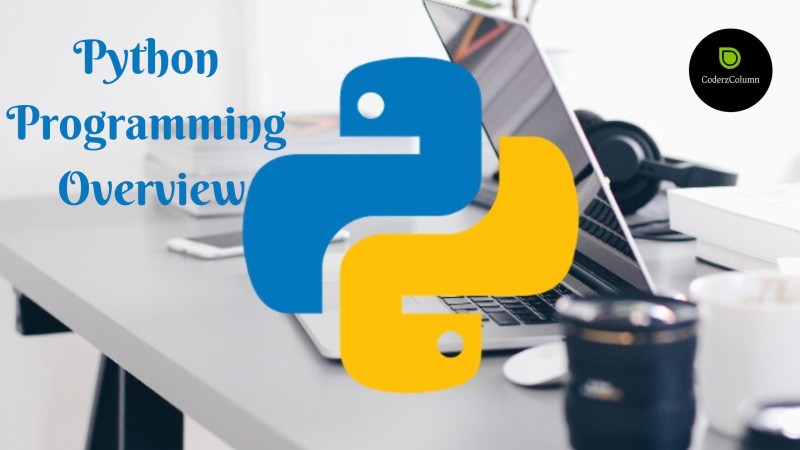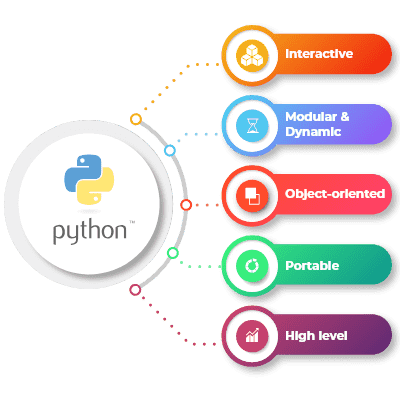
Complete Guide to Python Programming Language for Beginners¶
Table Of Content¶
- Python Programming Language Overview
- What This Article Is All About?
- What Is Python?
- History of Python Programming Language
- Python Versions
- Features Of Python
- The Rise Of Python
- How Python Is Different From Other Programming Languages?
- Pros And Cons Of Python
- Applications Of Python
- Famous Organizations Using Python
- Important Python Libraries
- Popular Python IDEs
- Career Options As A Python Programmer
- Best Python Books
- Python Project Ideas For Beginners
- How To Get Started With Python?
- How To Install Python?
> 1. Python Overview: ¶
In our digital world, we strive hard to get a perfect university education or land ourselves a high-profile job. You have to pass certain eligibility criteria that help you get into a good university or a multinational company. Sometimes, it might happen that even if you get into a good organization, you do not get the desired designation or projects to work on. It is because you lack certain coding skills.
Everything from website development to software testing to machine learning uses python. Both developers and non-developers can use it. If you are looking forward to developing your skills in the IT field or getting a job in the IT sector, this article is for you.
Python is a popular programming language. Developing coding skills in Python or doing a certified course will help you to get your dream job or desired designation.
What This Article Is All About?¶
- Ultimate Guide On Python Programming For Beginners
You will get to know why python language is so essential in today’s digital world. How python helps you develop different programs, projects, and games and resolve real-world issues. You will learn how python programming skills help you get a good designation or a university selection.
So what are we waiting for? Let’s get started!
What Is Python?¶
Python is an interpreted, object-oriented, high-level, dynamically semantic programming language. It is particularly desirable for Rapid Application Development as well as for usage as a scripting language to tie existing components together due to its high-level built-in data structures, dynamic typing, and dynamic binding.
Python's straightforward syntax prioritizes readability and makes it simple to learn, which lowers the cost of program maintenance. Python's support for modules and packages promotes the modularity and reuse of code in programs. For all popular platforms, the Python interpreter and the comprehensive standard library are freely distributable and available in source or binary form.
Python frequently causes programmers to fall in love with it due to the enhanced productivity it offers. The edit-test-debug cycle is extraordinarily quick because there is no compilation step. Python programs are simple to debug since a segmentation failure is never caused by a bug or incorrect input. Instead, the interpreter raises an exception when it finds a mistake.
The interpreter prints a stack trace if the application doesn't catch the exception. Setting breakpoints, evaluating arbitrary expressions, inspecting local and global variables, stepping through the code one line at a time, and other features are all possible with a source-level debugger. Python's ability to perform introspection is demonstrated by the debugger, which is developed in Python.

Points To Remember About Python Programming Language¶
Python Is Interpreted Language: The interpreter processes Python while it is being used. Your software does not need to be compiled before running. It has similar characteristics to PHP and PERL.
Python is Interactive: When writing programs, you can actually sit at a Python prompt and communicate with the interpreter directly.
Python supports the Object-Oriented programming style or approach, which encapsulates code within objects.
Python is an Excellent Language for Beginners: Python is a great language for novice programmers and facilitates the creation of a variety of programs, including simple text editors, web browsers, and games.
History of Python Programming Language¶
At the National Research Institute for Mathematics and Computer Science in the Netherlands, Guido van Rossum developed Python in the late 1980s and early 1990s.
ABC, Modula-3, C, C++, Algol-68, SmallTalk, the Unix shell, and other scripting languages are just a few that Python is derived.
Copyright applies to Python. Python source code is now accessible under the GNU General Public License, just like Perl (GPL).
Although a core development team at the institution is now responsible for maintaining Python, Guido van Rossum continues to play a key role in guiding its development.
What Are The Essential Features Of Python?¶
Easy-to-learn: Python has a concise syntax, straightforward structure, and minimal keywords. The student can swiftly pick up the language due to this.
Easy-to-read: Python program code has a clear and concise definition with easy understanding.
Easy-to-maintain: You can easily maintain Python's source code.
Python Offers A Standard Library For Simplified Coding − The majority of the Python library runs well on UNIX, Windows, and Macintosh and is fairly portable.
Python Offers An Interactive Mode − Python supports an interactive mode that enables real-time testing and debugging of code fragments.
Python Is Portable − Python has the same interface across all hardware platforms and can be executed on a variety of them.
Python Is Extendable − Low-level modules can be added to the Python interpreter. These modules give programmers the ability to enhance or modify their tools to make them more useful.
Databases − Python offers connections to all significant commercial databases.
GUI Programming − Python facilitates the creation and porting of GUI programs to a variety of system calls, libraries, and windows platforms, including Windows MFC, Macintosh, and the Unix X Window system.
Scalable − Compared to shell scripting, Python offers larger projects better structure and support.

Python Versions:¶
The two main versions of Python are 2x and 3x.
In 2000, Python 2.x was made available. The most recent version, 2.7, was published in 2010. It is not advised to be used in brand-new projects.
2008 saw the release of Python 3.x. In essence, Python 3 and Python 2 are incompatible. And for your new projects, you ought to use the most recent versions of Python 3.
Understanding The Rise Of Python (Reasons That Exhibit The Growth Of Python As A Programming Language)¶
Python is popular for several different reasons. Here is a critical analysis of what makes it so adaptable and simple for programmers to use. The points will also explain the rise of python in the digital world.
It is simpler to read and understand (simple syntax) because of its straightforward grammar, which mimics natural English. Project development and improvement are sped up as a result.
Python has a versatility feature. It shows that it is adaptable. Python can be used for a wide range of projects, including machine learning and web development.
It's user-friendly for beginners, making it popular among beginning programmers.
Being open source, it can be used and distributed without charge, even for profit.
Python has a sizable and expanding library and module repository, which are collections of code written by outside developers to enhance Python's functionality.
A sizable and vibrant community supports Python, adds to its collection of modules and libraries, and serves as a valuable resource for other programmers.
Because of the large support network, finding a solution to a coding problem is usually not too difficult because it is likely that someone else has already come into the same issue.
What Are The Requirements To Learn Python?¶
- Understanding of Computer Fundamentals.
- Understanding of Any Other Programming Language is an Advantage.
> 2. How Python Is Different From Other Programming Languages? ¶
- Learning Python is simple.
- Python is a wonderful choice for beginners because of its easy-to-understand syntax.
- In just a few lines of code, GUI and CGI may be created.
> 3. Elaborate On The Pros And Cons Of Python Programming Language ¶
What Are The Advantages Of Using Python?¶
Here are some of the advantages of Python Programming Language
- Python Is Simple To Learn, Understand And Read
- Python Programs Help Boost Overall Productivity
- Python Offers Huge Collection Of Standard Libraries
- Python Is Free, Open-source With Support Of A Huge Community
- Python - Is The Best Portable Programming Language
- Python Is An Interpreted Programming Language
- Python Offers IOT Opportunities
What Are The Disadvantages Of Python Programming Language?¶
- Design Problems: Complex designs are frequently a challenge for Python coders.
- More Slower Than Compiled Languages.
- Security: Python security is not perfect.
- The Workplace: You must set up a workspace before using Python.
- Memory Usage and Garbage Collection in Python: Python language uses a lot of memory, so this issue needs to be properly handled throughout the project.
- Python Uses Dynamic Typing
- Python's Multithreading: Python's multithreading is not quite real multithreading (GIL). Threads do not run concurrently under the Python multithreading architecture.

> 4. What Are The Applications Of Python? ¶
Here are Top 10 Real-World Applications of Python
1. Web Development¶
Python may be used to quickly create web applications.
2. Game Development¶
Interactive game development also makes use of Python.
3. Machine Learning and Artificial Intelligence¶
The most anticipated vocations for the future are being produced by machine learning and artificial intelligence, which are the talk of the town.
4. Data Science and Data Visualization¶
If you know how to extract the right information from data, you may use it to make more money by taking measured risks.
5. Desktop GUI¶
Python is what we use to create desktop applications.
You can start by making straightforward programmes like calculators and to-do apps before moving on to considerably more complex ones.
6. Web Scraping Applications¶
It is helpful in getting data and understanding procedures used in the real world, including job postings, pricing comparison, and research and development, among many others.

> 5. Famous Organizations That Employs Python ¶
Python is utilised by numerous large corporations, including Intel, IBM, NASA, Pixar, Netflix, Facebook, JP Morgan Chase, Spotify, and many others.
Python is one of Google's four primary programming languages, and it's used extensively in YouTube. The same is true of Instagram, Pinterest, and Reddit.
> 6. What Are Important Python Libraries? ¶
Below, we have listed some commonly used and famous Python libraries for different fields of computer science.
- Web Development - Django, Tornado, Flask, etc.
- AI (Deep Learning) - PyTorch, Keras, Tensorflow, JAX, MXNet, etc.
- Computer Vision - torchvision, opencv, gluoncv, etc.
- Natural Language Processing - nltk, spacy, torchtext, gluonnlp, gensim, trax, etc.
- Hyperparameters Tuning - keras-tuner
- Machine Learning - Scikit-Learn, Statsmodels, XGBoost, CatBoost, LightGBM, etc.
- Hyperparameters Tuning - optuna, scikit-optimize, hyperopt, bayes_opt, etc.
- Visualize ML Metrics - scikit-plot, yellowbrick, etc.
- Interpreting ML Models - lime, shap, eli5, captum, treeinterpreter, interpret-ml, interpret-text, dice-ml, etc.
- Data Science - missingno, seaborn, pandas, sweetviz, numpy, networkx, xarray, awkward-array, etc.
- Data Visualization - Matplotlib, Bokeh, Bqplot, Plotnine, Altair, Plotly, Cufflinks, Holoviews, etc.
- Dashboarding - dash, streamlit, panel, voila, bokeh, etc.
- Maps - geopandas, geoviews, folium, ipyleaflet, geoplot, cartopy, etc.
- Interactivity - ipywidgets
- Parallel Computing - Dask, Joblib, Ipyparallel, etc.
- Profiling Code - CProfile, Profile, line_profiler, memory_profiler, scalene, yappi, py-spy, pprofile, snakeviz, tracemalloc, pympler, guppy, etc.
Networking - requests, urllib, imaplib, smtplib, email, mimetypes, ipaddress, etc.
Multi-Tasking - Multiprocessing, threading, concurrent.futures, asyncio, subprocess, etc.
- Web Scraping - beautifulsoup, scrapy, urllib, requests, etc.
- Image Processing - Scikit-image, pillow (PIL), opencv, torchvision, gluoncv, etc.
- Speed Up Python Code - numba, numpy, etc.
CoderzColumn has tutorials on majority of libraries listed above. Please feel free to search them through search in header.

> 7. What Are Famous Python IDEs Among Developers? ¶
- IDLE
- PyCharm
- Visual Studio Code (VS Code)
- Sublime Text 3
- Atom
- Jupyter Notebook
- Spyder
- PyDev
- Thonny
- Wing
For detail, you can read the blog "Top 10 Python IDEs For Coders: Choose The Most Suitable One".

> 8. What Are The Career Options For You As A Python Programmer? ¶
What choices will be available to you once you've finished learning Python?
Here are a few positions you could hold:
1. Python Developer:¶
One of the careers that you might anticipate acquiring after learning Python is that of a developer. You can see from the statistics we provided in the last section that there will always be open openings for Python developers.
What does a developer of Python do? The following are some of your main roles and responsibilities:¶
- Create websites and address issues with data analytics
- Make use of reusable and effective coding techniques.
- Enhancing data algorithms
- Implement data security and protection
2. Data Analyst:¶
This is a really exciting chance. It is especially for people who enjoy working with enormous volumes of data and deciphering its meaning. Again, this is a pretty common work role. Many businesses are in need of workers who can handle the vast amounts of data they have at their disposal.
3. Machine Learning Engineer:¶
If you're unaware, let us inform you that during the past couple of years, the number of job posts for this position has surged by more than 330%. Python proficiency will offer you an advantage over other applicants. A machine learning engineer creates and educates programs, other computer-based systems, and machines to use learned information for prediction. Python is the best programming language to employ for machine learning because of its aptitude for data automation and algorithms.
Apart from this, you can also be a Reasearch Analyst, Software Developer, and Full-Stack developer. It will be based on the skills you develop during your career journey.

> 9. What Are The Best Python Books For A Python Programmer? ¶
1. Python Crash Course – 2nd Edition¶
Author: Eric Matthes

2. Head First Python¶
Author: Paul Barry

3. Python Cookbook: Recipes for Mastering Python 3¶
Author: David Beazely, Brian K. Jones

4. Automate the Boring Stuff with Python¶
Author: Al Sweigart

5. Learn Python 3 the Hard Way¶
Author: Zed A. Shaw

> 10. What Are Some Python Programming Project Ideas For Beginners? ¶
1. Python Mobile App Project Ideas¶
- an app to monitor your daily walking distance.
- a program that notifies you of the weather.
- a location-based live conversation.
2. Website Project Ideas¶
- a website that aids with weekly food planning.
- a website where individuals may evaluate video games.
- a system for taking notes.
- Python Game Project Ideas
- a mobile game with a location-based component where you seize territory.
- a game that involves programming puzzle solutions.
3. Hardware / Sensors / Robots Project Ideas¶
- sensors that allow you to remotely check on your house and monitor the temperature in it.
- improved alarm clock.
- a robot that can drive itself and recognize obstacles.
- Work Automation Project Ideas
- an automated data entering script.
- a tool for web data scraping.

> 11. How To Get Started With Python Programming? ¶
Follow The "Python for Beginners" Course At CoderzColumn
CoderzColumn offers you a complete Python programming course. Whether you are a beginner or an expert, you can enroll in the course and start learning for free.
Take Python Courses¶
Read Python Blogs/Tutorials¶
- Python Library Tutorials
- Python Blogs
- Python Programming Guide - Simple Python Programs
- Python Programming Guide For Beginners - Part 1
Take Python Quizzes¶
Python Web Stories¶
> 12. How To Install Python? ¶
Python Installation on Unix/Linux
- Update the APT Repository
- apt-get update
- Install Python
- apt-get install python3.6
- Verify Python
- When we type python in shell it shows default installed python that is 3.6.
- python
 Dolly Solanki
Dolly Solanki
![]() Want to Share Your Views? Have Any Suggestions?
Want to Share Your Views? Have Any Suggestions?
If you want to
- provide some suggestions on topic
- share your views
- include some details in tutorial
- suggest some new topics on which we should create tutorials/blogs



 Want to Share Your Views? Have Any Suggestions?
Want to Share Your Views? Have Any Suggestions? Python, beginners-guide
Python, beginners-guide
